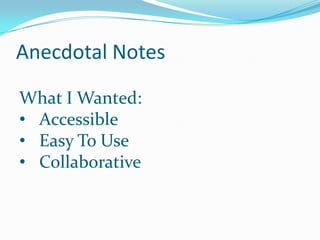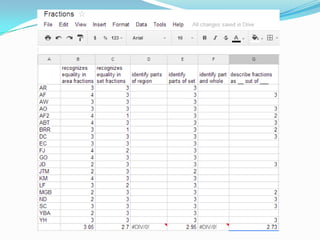Collecting and utilizing assessment information
- 4. Anecdotal Notes What I Wanted: • Accessible • Easy To Use • Collaborative
- 11. Quick Rankings What I Wanted: • Easy To Record • Easy to Sort
- 18. Across the Class View What I Wanted: • Entire Class in One Place • Ability to See Trends
- 21. Growth Over Time What I Wanted: • Track Individual Students • Use for Progress Reports • Data for IEPs
- 24. Image from coreycam’s flickr stream
- 25. Easy to Prep
- 27. Image from Enderst07’s flickr stream
Editor's Notes
- This isn’t really about the tool – what I want to share today comes from my need to do a couple of different things; collaboratively share anecdotal notes and form small groups for support based on need. Google docs is the best way I’ve found to do those things.
- These are my kiddos this year. In my classroom I have 20 first graders, two of whom are repeating first grade. Sixteen of them have an ESOL label and four have IEPs. Sixteen of them speak another language at home. As a school, 75% of our students receive free or reduced price lunches and we have a mobility rate of 17% (significantly down from the 30% of several years ago). Now that you’ve got the numbers, let me tell you about a few of these kiddos.
- One other important thing to know about my school, is that we use an inclusion model. ESOL teachers, special education teachers, literacy and math coaches, all push into classrooms rather than pulling students out. So a special education teacher is in my classroom for part of every day. She works with and gets to know our students well. What she knows about them is important for me to know as well.
- As an elementary teacher I take a lot of anecdotal notes, especially during writing conferences. I’ve come to realize that a significant majority of what I know about my students and their learning comes from listening to them and asking them questions, things I can really own capture in anecdotal notes.
- In my first dozen years of teaching I tried a plethora of ways of keeping anecdotal notes. I used labels in file folders like this, I used index cards, of different colors for different subjects, in a small box. I searched the internet, talked to colleagues, and still changed my method almost every year.Some systems lasted a couple of years, some didn’t even make it a year. The biggest challenge was in sharing those notes with other teachers but it was also challenging to find a way to keep the notes that wasn’t immensely time consuming but had everything right where I could review it easily.
- (These are anecdotal notes from writing conferences with a first grader.) Agoogle doc solved both these problems. It’s easy for me to quickly review notes from previous conferences. It’s also easy to share with someone else – they can see what I’ve done if they are working on an IEP or they can add to it if they are meeting with the student.
- These notes are from this year. Obviously I haven’t had too many writing conferences yet – I don’t even start until we’re about a month into the year and have our routines well established. Here you can see a bit more of what we thought was important to have in our notes. Sometimes we have a follow-up, something that we want to check up on in the next conference. It’s more pressing than other parts of our notes, we pulled it out to highlight it and it’s where I look first when I open a doc. We also put a place for us to record our initials when we meet with a student (this year it’s likely to only be me because the time the special education teacher is in my room she is focused on reading groups). Having the initials means we can ask each other about something perplexing. If it’s my initials and I don’t understand the notes, then I’m just stuck!
- An unexpected bonus was the fact that google docs sorts by date. So it’s easy to see who I haven’t met with in a while. Anecdotal notes, like ones for writing conferences, are kept by student. I’m not trying to compare students to one another, I am simply trying to follow growth and meet individual need. That said, I do form small groups for guided writing based on common needs so I keep a file of notes about things I’m seeing multiple students struggle with or need a push in. By the way, if you do this on an iPad in the google drive app you lose this bonus. Using that I have to scroll through the docs and look at dates real quick.
- Forming small groups in math or science or social studies, looks different for me.
- My school district has moved to standard based progress reports at the elementary level. I love this, both as a teacher and as a parent. But I’ll stay off that soapbox for the moment! These are the rubrics for that progress report and they work pretty well for my use throughout the year.
- I use spreadsheets for each unit (sometimes multiple per unit depending on the complexity of the content). Each indicator gets a column and as I meet with students or observe them working I note their level of understanding, on a scale of 1-4, just like the elementary progress report.
- Here’s one with a bit fewer objectives. I average each column as well because that gives me a quick sense of the whole class level of understanding.
- I can sort each column to pull out kids who need more help in that area or kids who need to be stretched further. Here I can see that most of my kids have a pretty good grasp on the concept of equality in set fractions. There are four kids I would probably pull out for a group for some added support.
- The fascinating thing for me, when I sort it, is to quickly glance at other objectives. Two of those kids I think need more support in equality in set fractions are doing great in equality in area models. Hmm…maybe I can build on that to help them with set models. Also, there are kids doing fine with set models but struggling with area models. Maybe my group should include all of them and we should look at both models together to better make that connection.
- The averages for each column help me see the whole-class view. That way I can quickly see if there is an objective that really needs more time as an entire class rather than just a small group.
- Sometimes I want another view of my class. These are the 25 high frequency words our kindergartners work on. Based on an assessment in the fall I can see how many kids could write each word correctly. I’ve got totals for each word, which helps me know which words we need to practice more and which ones the majority of kids already know and totals for each kid. That helps me see which students did not retain these words over the summer or never truly had them in kindergarten so I can offer them some extra support.
- Occasionally I’ll do averages for an objective (or task, as the case is here) and averages for each child. I don’t always bother with averages for each individual but there are times when I want to see it. These are performance tasks required by our district in math. I can see from this that my students are stronger with measurement than with the other and that graphing is definitely something we need more time on. I can also see those kids at 2 or 1.5 that worry me and I need to look more closely at their tasks to see what is going on.
- Sometimes it is really helpful to have a record of growth over time. I wanted that to be easy. I keep student work throughout the year, but not all of it as parents want to see it too. Google docs tracks changes as you go so I can, if necessary, look back and see a child’s progress.
- I can look back at previous versions to see a child’s level at various times. That helps me see how quickly they grew. You can also see here a notes box. Sometimes just a number is not enough. I need to record a quick anecdotal about something. I can always add that at the end of the spreadsheet.
- Our jobs are big enough and busy enough without making something complicated. I can create spreadsheets ahead of time based on objectives or my own knowledge. I can also take last year’s spreadsheets and copy them for this year.
- I create a template each fall with all my kids names down the side and the averages at the bottom. That way I can create new spreadsheets quickly as I find I want them.



























